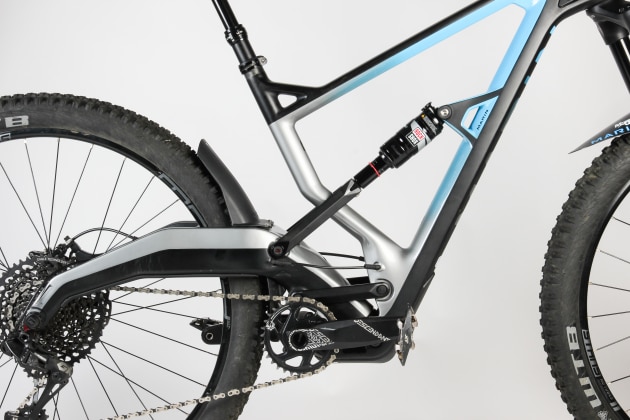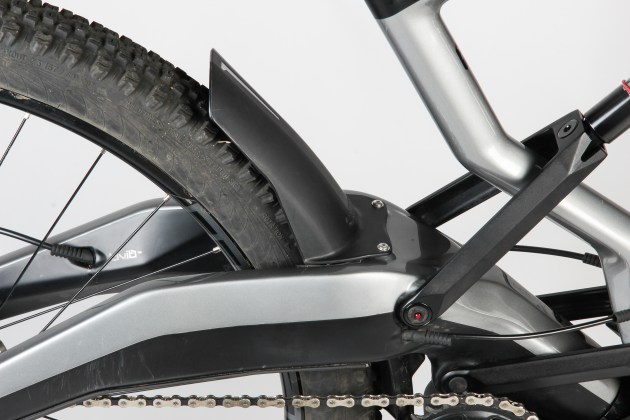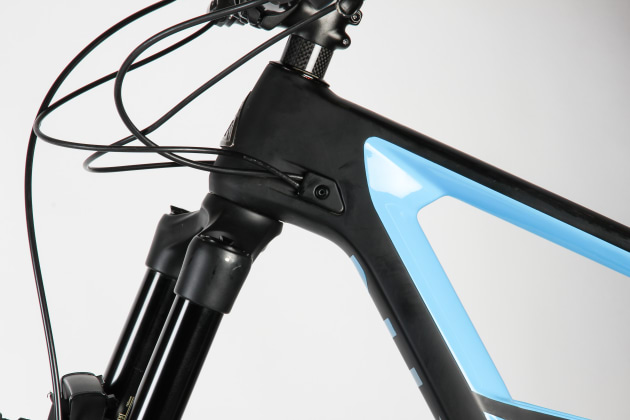Pluses
Stunning efficiency for a 160mm travel rig
Loves to drift with control
All round trail bike capability
Minuses
Polarising aesthetic
Suspension firms up when climbing
Not the best cable routing execution
Intro
Standing in the chairlift queue at Thredbo, the conversation began; “Why aren't you riding up? At least you'll be set if the lift breaks down.”
I'd only had one quick pedal on the Marin prior to heading to Snowy Mountains—it was no more than a scoot around the driveway but it was enough to know that this bike pedalled very efficiently. Perhaps my newfound friend was already aware of its pedalling prowess. Alas this wasn't the case and he'd simply mistaken the unusually shaped Wolf Ridge for an e-bike!
The Wolf Ridge isn't just visually different, the suspension platform is pretty unique too.
Marin is one of only two brands worldwide using the Darrell Voss-designed Naild R3ACT suspension system, with the other being Indonesian brand Polygon. Where Polygon puts the Naild suspension to task on a hard-hitting 180mm travel 27.5-inch rig that we've already tested - and raved about - Marin uses it to milk 160mm of travel out of its Wolf Ridge 29er.
With this design Marin claims to have finally solved the conflicting demands of pedalling efficiency and ground hugging suspension performance, and with no compromises. As a result the Wolf Ridge is pitched as an all-rounder, not a gravity-focused enduro bike like most 160mm travel 29ers.
In the Stand
You can choose between three different Wolf Ridge models, all of which utilise the same full-carbon frame, including the $9,499 SRAM XX1-equipped version with SRAM Descendant carbon cranks and Guide Ultimate brakes. There’s also the Wolf Ridge 9, which offers SRAM Eagle XO1 with carbon SRAM cranks, Guide RS brakes and Stans Flow Mk3 wheels, along with RockShox Lyrik RCT3 and Monarch R suspension. At $7999, it's once again more expensive than the equivalent spec Polygon, but in line with the offerings from many other price-competitive brands.
We tested the base level Wolf Ridge 8; at $5999 it's not a budget bike by any stretch but it really doesn't lose out when compared to the higher-end offerings. It still runs the same full-carbon frame/swingarm with a Lyrik fork and Eagle drivetrain. Naturally the spec level is slightly lower, with an RC fork and GX running gear. There's no carbon cranks (they're SRAM Descendant alloy) but the rims are still Stans Flow Mk3 with a healthy 29mm inner width.

The bar/stem combo consists of simple house-branded alloy parts; at 45mm the stem is nice and short while the bars are 780mm wide with a comfortable bend and sweep. WTB supplies the 29x2.3 Bronson/Breakout tyres; at 61mm across the casing they're a good width and they’re respectably light, too. A WTB Volt Race saddle completes what is a relatively frill-free but totally functional package.
Of course parts are just parts and there are a bazillion GX-equipped carbon duallies on the market—it's the frame and suspension that really sets the Marin apart.

The frame is carbon from head tube to rear dropout, with a number of well-considered finishing touches. There's a tidy rubber slap-guard under the elevated chainstay, a built-in mud guard over the rear tyre and a moulded nylon guard to protect the low-slung down tube/bottom bracket region—while I don't remember bashing this part of the frame, the post-review scuff marks show that the protector does its job.
Large ports with bolt-on covers help to lock the internally routed cables in place at the head tube. The same can’t be said for the rubber grommets used lower down on the frame, though; as a result, the cables would creep, develop slack and rattle inside the frame from time to time. It's a shame, as the rubber sheathed elevated chainstay makes the Wolf Ridge an otherwise silent trail bike. A simple solution would be to slip some foam-rubber tubes over the down-tube cables.
Tyre clearance is good, with room for up to 2.4 or 2.5-inch rubber within the elevated chainstay rear end. As with the Naild R3ACT equipped Polygon, the rear end incorporates a proprietary thru-axle that ties the swing-arm together. While the built-in locking red button takes some getting used to, it only requires quick turn to undo and is quicker to remove than other more simplistic designs. As with many modern bikes, you can't run a drink bottle inside the main triangle, while front derailleur compatibility is a thing of the past. It does, however cater to chain guide mounting, with ISCG tabs down near the bottom bracket.

As tested, the complete bike weighed 14.4kg (without pedals); certainly not light, but ion par with most 160mm travel 29ers at a comparable spec level.
On the Trail
Visually the suspension may baffle, but it's easiest to understand if you look at it like a short-link dually. The lower pivot is formed by a sliding stanchion which is housed within the massive swingarm; it works like a really long link with a linear path. The upper link follows a more traditional line, and the two combine to shape the axle path and suspension kinematic.
With two links controlling the swingarm movement, it's not dissimilar to a DW-Link, VPP or Maestro design, with Yeti's Switch Infinity linear rail system standing as its closest cousin, at least from a raw nuts and bolts perspective. Of course small variations in pivot placement and design can have a big impact on the end result, and the Marin stands as a very unique beast.

From its side, Marin claims the Wolf Ridge offers 'unparalleled pedalling efficiency', so much so that the rear suspension can be tuned with around 40 per cent less damping. This super light shock tune applies to both compression and rebound circuits, with the goal of making the suspension more active and able to follow the terrain. Marin refers to it as a 'ground tracing suspension.'
I've been around mountain bikes for over three decades now, and claims such as this do provoke a fair bit of eye-rolling. After all, just about every manufacturer claims their bike pedals like an XC racer and descends like DH bike; we've heard it all before! There are a number of bikes that pedal with a good level of efficiency and descend brilliantly, but I can confidently say that the Naild-equipped Marin does step things up a notch from a pure pedalling efficiency standpoint.
For a bike with 160mm of travel at both ends, the Wolf Ridge gets up and goes like a rocket ship. There's virtually no unwanted suspension movement under power, even when sprinting as hard as you can out of the saddle, and that's without any form of lock-out or pedal platform (the Monarch R shock has neither). If it wasn't for its 13.6kg heft, you could legitimately race this thing competitively at an XC event.
Long travel and amazing efficiency, you say? So what's the catch? Many solid-pedalling longer travel bikes employ high levels of anti-squat, and with this you get a lot of chain growth; this means the length of the chainstays increases markedly as the suspension is compressed, providing a distinctly rearward axle path. Under pedal power, chain torque pulls the rear wheel in towards the bottom bracket.
These two forces oppose each other and, when in equilibrium, you get bob-free suspension while pedalling. With every pro there's a con, of course, and high levels of chain growth can result in pedal kick-back (where you feel the chain tugging back on the cranks when hitting bumps) or inactive suspension (where the rear wheel doesn't track the ground under hard pedalling).
The Wolf Ridge has lots of chain growth, with the chainstay length increasing from a relatively compact 335mm up to 466mm at full compression. That equates to over 30mm of chain growth, where 20mm would be a more normal figure for a bike with 160mm of travel. On the trail, however, I never really noticed any disruption to my pedalling rhythm when climbing on technical terrain. If anything, there was a sense that the rear wheel was being driven into the trail, seeking out the traction.
The only negative I picked up on was that the suspension firmed up under hard pedalling, so the bike wasn't as plush when climbing up rock ledges. At the end of the day, it proved to be a sprightly and efficient climber that pedalled uphill as if it had a lot less than 160mm of travel.
The geometry also helped with making the Wolf Ridge a competent climber. It's not uncommon to see long-travel 29ers sporting 65-degree head angles these days. At 65.5 degrees, the Marin’s head angle is more trail than pure gravity based.
The only thing that could undermine its climbing prowess is the seat angle. Marin says the bike has a 73.5 degree effective seat angle, which is a fairly conservative middle-of-the-trail figure. However, if you ride a smallish frame relative to your height with lots of seatpost showing, the actual slack seat angle can really push the saddle back, and the offset head on the KS dropper only serves to exacerbate this. A rearward bias on the saddle position can make it harder to keep the front wheel grounded on steep seated climbs. At 177cm tall, I didn't face any of these potential problems on the large Wolf Ridge test bike, though. The saddle position was just right, too, with enough room for the 150mm travel dropper.
With 160mm of travel and 29-inch wheels, the Wolf Ridge stacks up against some heavy hitters in the enduro world; real gravity-focused machines that are only a hair away from a DH bike when it comes to pinning it downhill. While the suspension is plush and active when descending, the bike as a whole isn't as confident when it comes to the steepest and gnarliest terrain. This is in part due to the steepish head angle – steep when compared to the enduro big hitters, anyway – and the more trail/XC oriented inline shock also plays a role.
I'm certainly not calling the Wolf Ridge a poor descender; it just felt a bit out of its depth and harder to manage on the really steep stuff when compared to a true gravity focused rig.
Where it truly shines is on the more intermediate stuff and in general trail riding applications. With all that travel, it offers a super comfortable ground-hugging ride without paying an efficiency penalty on the climbs. In addition to the vertical travel, the one-piece swingarm also provides an element of lateral give. Many assume that stiffer is better, but the lateral compliance in the rear end serves to smooth the ride when you've got the bike leaning over mid-turn. It was also easier to control in a drift, which really bolsters the confidence factor on fast flowy trails.
Verdict
Based purely on the amount of suspension travel, you might expect the Wolf Ridge to be little more than a big-wheeled gravity sled. However, this assumption will lead you astray. It mightn't rule the roost on really steep and challenging descents, but it more than holds its own while dispatching long fire trail climbs more effectively and efficiently than any big travel 29er has a right to.
It absolutely rails on technical singletrack, too, offering a very comfortable and forgiving ride with 160mm of travel to keep you fresh. The impressive pedalling efficiency makes it ideal for full-day epics, and the lightly damped suspension irons out the bumps and keeps the tyres glued to the trail.
It's unrealistic to expect one bike to be perfect for all riding situations; from XC racing to full-on downhill, it's not going to happen. However, the Wolf Ridge manages to excel at anything shy of the absolute extremes; it really is a brilliant all-rounder.
Score
In the stand – 6/10
On the trail – 8/10
Overall 7
Judge’s Notes
Name – John Hardwick
Age – 47
Weight – 65kg
Riding Style – Likes to play around
Home Trail – Wollongong; anything steep, raw and tech
Size Tested – Large
Suspension Settings:
Front – 65psi with two tokens
Rear – 190psi (30% sag)
Tyre Pressure: 22/23psi (F/R)
Specifications
Frame Full unidirectional carbon
Shock RockShox Monarch R Debonair, 160mm travel
Fork RockShox Lyrik RC, 160mm travel
Headset FSA sealed bearing
Handlebar Marin 6061 DB Alloy 780mm
Stem Marin 3D Forged alloy 45mm
Shifter SRAM GX Eagle
Rear Derailleur SRAM GX Eagle
Cassette SRAM GX Eagle 12-speed, 10-50
Chain SRAM Eagle
Cranks SRAM Descendant 34T
Bottom Bracket SRAM press-fit
Brakes Shimano XT
Wheels Stan's Flow MK3 w/Formula hubs
TyresWTB Vigilante/Breakout 2.3
Saddle WTB Volt Race
Seatpost KS Lev SIO, 150mm drop
Weight 13.6kg without pedals (frame/shock 2,900g)
Wheel Size 29-inch
Available Sizes S, M, L (tested), XL
Price $5,999











